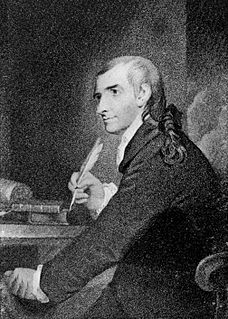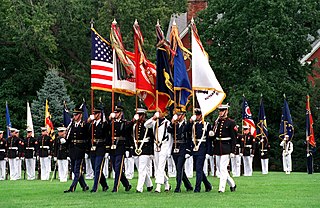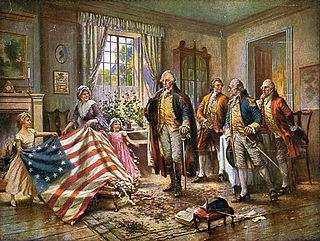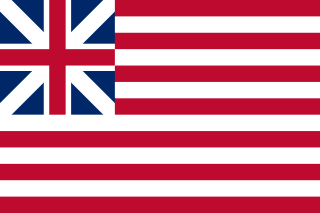
The Brandywine flag was a banner carried by Captain Robert Wilson's company of the 7th Pennsylvania Regiment. The company flag received the name after it was used in the Battle of Brandywine, September 11, 1777. The flag is red, with a red and white American flag image in the canton. [1]

The 7th Pennsylvania Regiment was an infantry unit raised on 4 January 1776 at Carlisle, Pennsylvania for service with the Continental Army during the American Revolutionary War. On 17 January 1777 Lieutenant Colonel Thomas Hartley transferred out of the unit to take command of Hartley's Additional Continental Regiment. The 7th Regiment saw action at the battles of Brandywine, Paoli, Germantown, Monmouth, Springfield and Bull's Ferry. At Monmouth, Colonel William Irvine led the regiment. The unit merged with the 4th Pennsylvania Regiment on 17 January 1781.

The Battle of Brandywine, also known as the Battle of Brandywine Creek, was fought between the American Continental Army of General George Washington and the British Army of General Sir William Howe on September 11, 1777. The "Redcoats" of the British Army defeated the American rebels in the Patriots' forces and forced them to withdraw northeast toward the American capital and largest city of Philadelphia where the Second Continental Congress had been meeting since 1775. The engagement occurred near Chadds Ford, Pennsylvania during Howe's campaign to take Philadelphia, part of the American Revolutionary War (1775-1783). More troops fought at Brandywine than any other battle of the American Revolution. It was also the longest single-day battle of the war, with continuous fighting for 11 hours.
Other stories indicate that the flag may have actually flown earlier, at the Battle of Cooch's Bridge in Delaware on 3 September 1777. [2] Captain Wilson may have also brought it to the Battle of Paoli on 21 September and the Battle of Germantown on 4 October. [3]
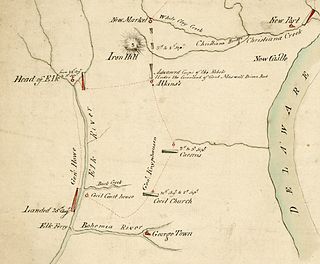
The Battle of Cooch's Bridge, also known as the Battle of Iron Hill, was a battle fought on September 3, 1777, between the Continental Army and American militia and primarily German soldiers serving alongside the British Army during the American Revolutionary War. It was the only significant military action during the war on the soil of Delaware, and it took place about a week before the major Battle of Brandywine. Reportedly, the battle that saw the first flying of the U.S. flag.

Delaware is one of the 50 states of the United States, in the South-Atlantic or Southern region. It is bordered to the south and west by Maryland, north by Pennsylvania, and east by New Jersey and the Atlantic Ocean. The state takes its name from Thomas West, 3rd Baron De La Warr, an English nobleman and Virginia's first colonial governor.
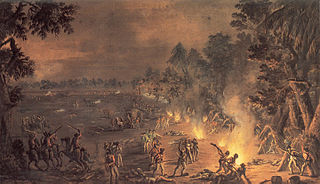
The Battle of Paoli was a battle in the Philadelphia campaign of the American Revolutionary War fought on September 20, 1777, in the area surrounding present-day Malvern, Pennsylvania. Following the American retreats at the Battle of Brandywine and the Battle of the Clouds, George Washington left a force under Brigadier General Anthony Wayne behind to monitor and harass the British as they prepared to move on the revolutionary capital of Philadelphia. On the evening of September 20, British forces under Major General Charles Grey led a surprise attack on Wayne's encampment near the Paoli Tavern. Although there were relatively few American casualties, claims were made that the British took no prisoners and granted no quarter, and the engagement became known as the "Paoli Massacre."
The 7th Pennsylvania Flag may have been one of the first American flags to feature stars and stripes, although it was a militia company's flag, not a flag of Washington's army. [4] The Flag Resolution of 1777 defined the official flag of the United States as having 13 stripes and 13 stars, although the specific pattern of the stars was not specified. Many variations existed. The flag shown in the canton of the Brandywine Flag uses a 4-5-4 star pattern, and was probably patterned after a Hopkinson-style United States flag.
The Brandywine Flag is currently displayed in Philadelphia's Independence National Historical Park, [3] and was featured on a 33¢ postage stamp issued in 2000, as a part of the US Postal Service's Stars and Stripes series. The colors and pattern on the stamp may have been altered for aesthetic purposes.

Philadelphia, sometimes known colloquially as Philly, is the largest city in the U.S. state and Commonwealth of Pennsylvania, and the sixth-most populous U.S. city, with a 2017 census-estimated population of 1,580,863. Since 1854, the city has been coterminous with Philadelphia County, the most populous county in Pennsylvania and the urban core of the eighth-largest U.S. metropolitan statistical area, with over 6 million residents as of 2017. Philadelphia is also the economic and cultural anchor of the greater Delaware Valley, located along the lower Delaware and Schuylkill Rivers, within the Northeast megalopolis. The Delaware Valley's population of 7.2 million ranks it as the eighth-largest combined statistical area in the United States.
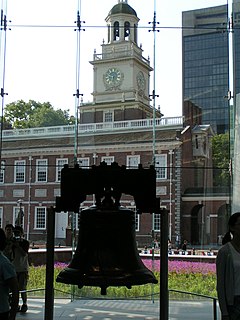
Independence National Historical Park is a United States National Park in Philadelphia that preserves several sites associated with the American Revolution and the nation's founding history. Administered by the National Park Service, the 55-acre (22 ha) park comprises much of Philadelphia's most-visited historic district. The park has been nicknamed "America's most historic square mile" because of its abundance of historic landmarks, and the park sites are located within the Old City and Society Hill neighborhoods of Philadelphia.

The United States Postal Service is an independent agency of the executive branch of the United States federal government responsible for providing postal service in the United States, including its insular areas and associated states. It is one of the few government agencies explicitly authorized by the United States Constitution.
